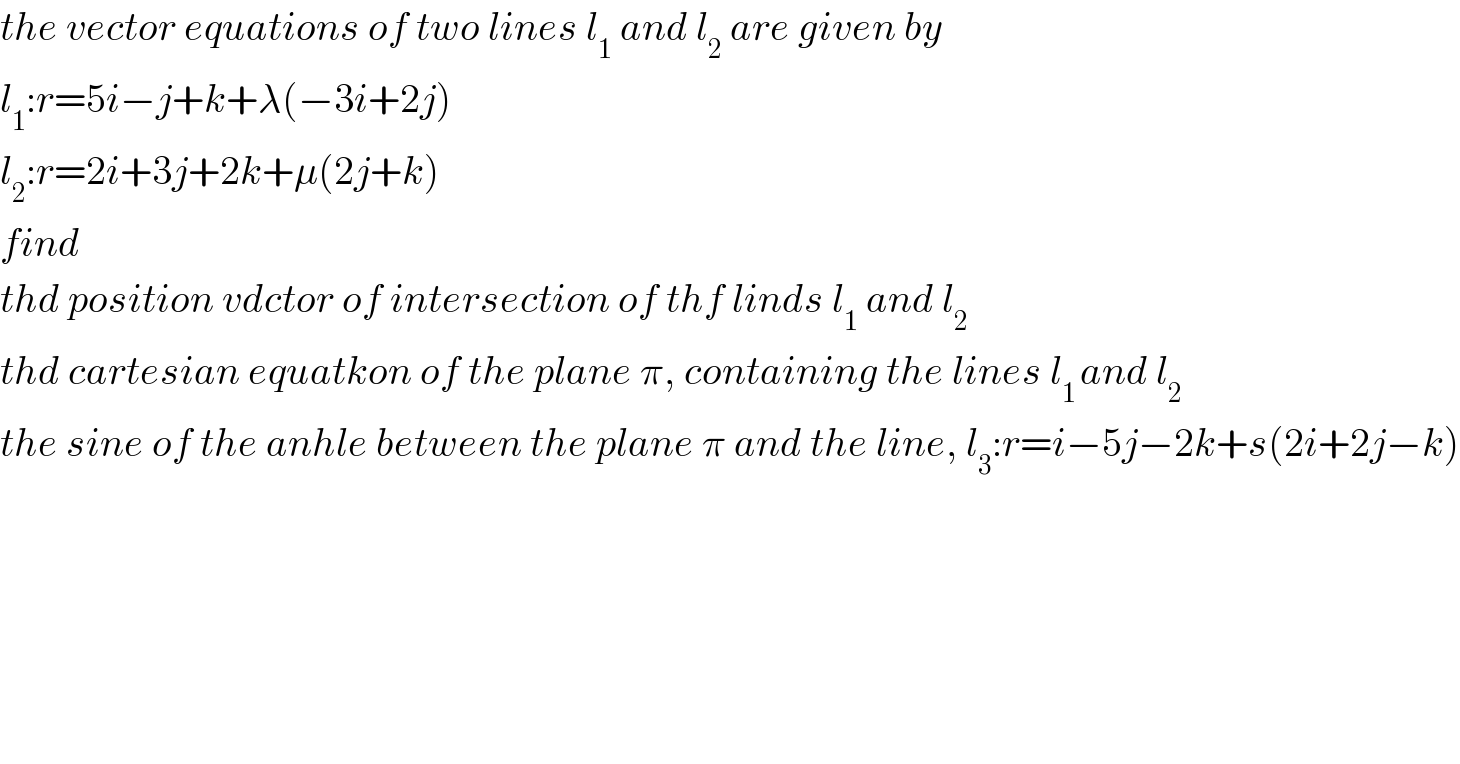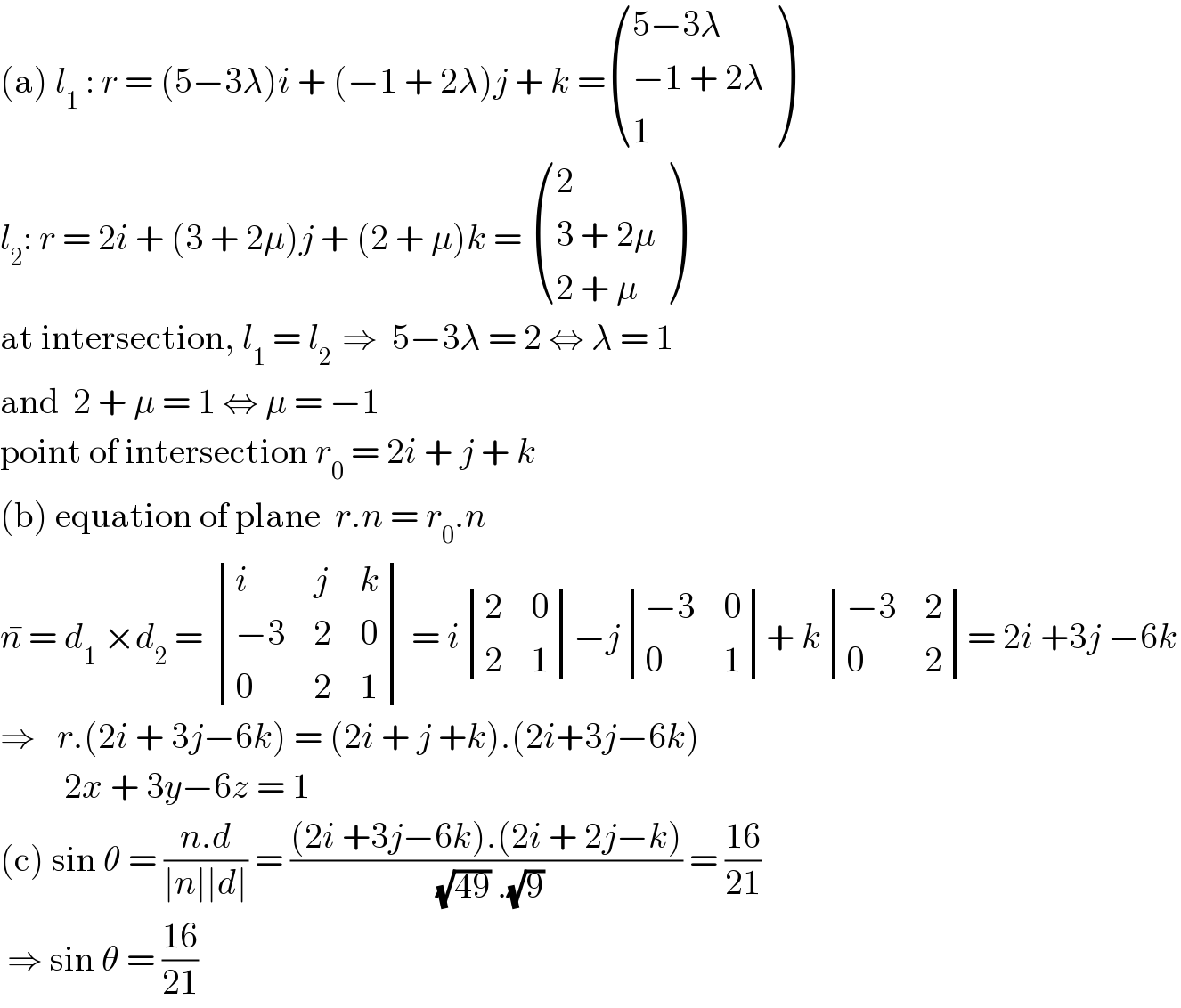Question Number 98018 by hardylanes last updated on 11/Jun/20

$${the}\:{vector}\:{equations}\:{of}\:{two}\:{lines}\:{l}_{\mathrm{1}} \:{and}\:{l}_{\mathrm{2}} \:{are}\:{given}\:{by} \\ $$$${l}_{\mathrm{1}} :{r}=\mathrm{5}{i}−{j}+{k}+\lambda\left(−\mathrm{3}{i}+\mathrm{2}{j}\right) \\ $$$${l}_{\mathrm{2}} :{r}=\mathrm{2}{i}+\mathrm{3}{j}+\mathrm{2}{k}+\mu\left(\mathrm{2}{j}+{k}\right) \\ $$$${find} \\ $$$${thd}\:{position}\:{vdctor}\:{of}\:{intersection}\:{of}\:{thf}\:{linds}\:{l}_{\mathrm{1}} \:{and}\:{l}_{\mathrm{2}} \: \\ $$$${thd}\:{cartesian}\:{equatkon}\:{of}\:{the}\:{plane}\:\pi,\:{containing}\:{the}\:{lines}\:{l}_{\mathrm{1}\:} {and}\:{l}_{\mathrm{2}} \\ $$$${the}\:{sine}\:{of}\:{the}\:{anhle}\:{between}\:{the}\:{plane}\:\pi\:{and}\:{the}\:{line},\:{l}_{\mathrm{3}} :{r}={i}−\mathrm{5}{j}−\mathrm{2}{k}+{s}\left(\mathrm{2}{i}+\mathrm{2}{j}−{k}\right) \\ $$
Answered by Rio Michael last updated on 11/Jun/20

$$\left(\mathrm{a}\right)\:{l}_{\mathrm{1}} \::\:{r}\:=\:\left(\mathrm{5}−\mathrm{3}\lambda\right){i}\:+\:\left(−\mathrm{1}\:+\:\mathrm{2}\lambda\right){j}\:+\:{k}\:=\begin{pmatrix}{\mathrm{5}−\mathrm{3}\lambda}\\{−\mathrm{1}\:+\:\mathrm{2}\lambda}\\{\mathrm{1}}\end{pmatrix} \\ $$$${l}_{\mathrm{2}} :\:{r}\:=\:\mathrm{2}{i}\:+\:\left(\mathrm{3}\:+\:\mathrm{2}\mu\right){j}\:+\:\left(\mathrm{2}\:+\:\mu\right){k}\:=\:\begin{pmatrix}{\mathrm{2}}\\{\mathrm{3}\:+\:\mathrm{2}\mu}\\{\mathrm{2}\:+\:\mu}\end{pmatrix} \\ $$$$\mathrm{at}\:\mathrm{intersection},\:{l}_{\mathrm{1}} \:=\:{l}_{\mathrm{2}\:} \:\Rightarrow\:\:\mathrm{5}−\mathrm{3}\lambda\:=\:\mathrm{2}\:\Leftrightarrow\:\lambda\:=\:\mathrm{1} \\ $$$$\mathrm{and}\:\:\mathrm{2}\:+\:\mu\:=\:\mathrm{1}\:\Leftrightarrow\:\mu\:=\:−\mathrm{1} \\ $$$$\mathrm{point}\:\mathrm{of}\:\mathrm{intersection}\:{r}_{\mathrm{0}} \:=\:\mathrm{2}{i}\:+\:{j}\:+\:{k} \\ $$$$\left(\mathrm{b}\right)\:\mathrm{equation}\:\mathrm{of}\:\mathrm{plane}\:\:{r}.{n}\:=\:{r}_{\mathrm{0}} .{n} \\ $$$$\bar {{n}}\:=\:{d}_{\mathrm{1}} \:×{d}_{\mathrm{2}} \:=\:\begin{vmatrix}{{i}}&{{j}}&{{k}}\\{−\mathrm{3}}&{\mathrm{2}}&{\mathrm{0}}\\{\mathrm{0}}&{\mathrm{2}}&{\mathrm{1}}\end{vmatrix}\:=\:{i}\begin{vmatrix}{\mathrm{2}}&{\mathrm{0}}\\{\mathrm{2}}&{\mathrm{1}}\end{vmatrix}−{j}\begin{vmatrix}{−\mathrm{3}}&{\mathrm{0}}\\{\mathrm{0}}&{\mathrm{1}}\end{vmatrix}+\:{k}\begin{vmatrix}{−\mathrm{3}}&{\mathrm{2}}\\{\mathrm{0}}&{\mathrm{2}}\end{vmatrix}=\:\mathrm{2}{i}\:+\mathrm{3}{j}\:−\mathrm{6}{k} \\ $$$$\Rightarrow\:\:\:{r}.\left(\mathrm{2}{i}\:+\:\mathrm{3}{j}−\mathrm{6}{k}\right)\:=\:\left(\mathrm{2}{i}\:+\:{j}\:+{k}\right).\left(\mathrm{2}{i}+\mathrm{3}{j}−\mathrm{6}{k}\right) \\ $$$$\:\:\:\:\:\:\:\:\:\mathrm{2}{x}\:+\:\mathrm{3}{y}−\mathrm{6}{z}\:=\:\mathrm{1} \\ $$$$\left(\mathrm{c}\right)\:\mathrm{sin}\:\theta\:=\:\frac{{n}.{d}}{\mid{n}\mid\mid{d}\mid}\:=\:\frac{\left(\mathrm{2}{i}\:+\mathrm{3}{j}−\mathrm{6}{k}\right).\left(\mathrm{2}{i}\:+\:\mathrm{2}{j}−{k}\right)}{\:\sqrt{\mathrm{49}}\:.\sqrt{\mathrm{9}}}\:=\:\frac{\mathrm{16}}{\mathrm{21}} \\ $$$$\:\Rightarrow\:\mathrm{sin}\:\theta\:=\:\frac{\mathrm{16}}{\mathrm{21}} \\ $$
Commented by hardylanes last updated on 11/Jun/20
thanks again
Commented by peter frank last updated on 11/Jun/20

$$\mathrm{good} \\ $$
